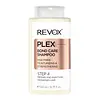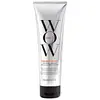What's inside
What's inside
 Key Ingredients
Key Ingredients

No key ingredients
 Benefits
Benefits

 Concerns
Concerns

 Ingredients Side-by-side
Ingredients Side-by-side

Water
Skin ConditioningCoco-Betaine
CleansingSodium Methyl Cocoyl Taurate
CleansingSodium Cocoyl Isethionate
CleansingCocamidopropyl Betaine
CleansingWater, Coco-Betaine, Sodium Methyl Cocoyl Taurate, Sodium Cocoyl Isethionate, Cocamidopropyl Betaine, Hydrolyzed Keratin, Polyquaternium-22, PEG-120 Methyl Glucose Trioleate, Propylene Glycol, Parfum, Styrene/Acrylates Copolymer, Coco-Glucoside, Sodium Benzoate, Citric Acid, Phenoxyethanol, Potassium Sorbate
Water
Skin ConditioningSodium Methyl 2-Sulfolaurate
CleansingCocamidopropyl Hydroxysultaine
CleansingSodium Cocoyl Isethionate
CleansingSodium Lauryl Sulfoacetate
CleansingSodium Lauroamphoacetate
CleansingSodium Methyl Cocoyl Taurate
CleansingGlycerin
HumectantPhenoxyethanol
PreservativeDisodium 2-Sulfolaurate
CleansingParfum
MaskingSodium Cocoyl Glycinate
CleansingSodium PCA
HumectantPEG-150 Distearate
EmulsifyingPropylene Glycol
HumectantPolyquaternium-22
Chlorphenesin
AntimicrobialPPG-2 Hydroxyethyl Cocamide
EmulsifyingBenzoic Acid
MaskingDisodium EDTA
Dehydroacetic Acid
PreservativeCitric Acid
BufferingHydrolyzed Wheat Starch
Skin ConditioningHydrolyzed Wheat Protein
Skin ConditioningHydrolyzed Keratin
HumectantPotassium Benzoate
PreservativeButylene Glycol
HumectantTocopheryl Acetate
AntioxidantPotassium Sorbate
PreservativeBHA
AntioxidantCitronellol
PerfumingLinalool
PerfumingHexyl Cinnamal
PerfumingWater, Sodium Methyl 2-Sulfolaurate, Cocamidopropyl Hydroxysultaine, Sodium Cocoyl Isethionate, Sodium Lauryl Sulfoacetate, Sodium Lauroamphoacetate, Sodium Methyl Cocoyl Taurate, Glycerin, Phenoxyethanol, Disodium 2-Sulfolaurate, Parfum, Sodium Cocoyl Glycinate, Sodium PCA, PEG-150 Distearate, Propylene Glycol, Polyquaternium-22, Chlorphenesin, PPG-2 Hydroxyethyl Cocamide, Benzoic Acid, Disodium EDTA, Dehydroacetic Acid, Citric Acid, Hydrolyzed Wheat Starch, Hydrolyzed Wheat Protein, Hydrolyzed Keratin, Potassium Benzoate, Butylene Glycol, Tocopheryl Acetate, Potassium Sorbate, BHA, Citronellol, Linalool, Hexyl Cinnamal
 Reviews
Reviews

Ingredients Explained
These ingredients are found in both products.
Ingredients higher up in an ingredient list are typically present in a larger amount.
Citric Acid is an alpha hydroxy acid (AHA) naturally found in citrus fruits like oranges, lemons, and limes.
Like other AHAs, citric acid can exfoliate skin by breaking down the bonds that hold dead skin cells together. This helps reveal smoother and brighter skin underneath.
However, this exfoliating effect only happens at high concentrations (20%) which can be hard to find in cosmetic products.
Due to this, citric acid is usually included in small amounts as a pH adjuster. This helps keep products slightly more acidic and compatible with skin's natural pH.
In skincare formulas, citric acid can:
While it can provide some skin benefits, research shows lactic acid and glycolic acid are generally more effective and less irritating exfoliants.
Most citric acid used in skincare today is made by fermenting sugars (usually from molasses). This synthetic version is identical to the natural citrus form but easier to stabilize and use in formulations.
Read more about some other popular AHA's here:
Learn more about Citric AcidHydrolyzed Keratin is derived from keratin. Keratin is a large protein that is naturally found in our hair and skin.
Studies show keratin is able to seal broken hair cuticles, helping to prevent split ends and breakage.
As a humectant, hydrolyzed keratin helps draw moisture from the air to your hair and skin. This helps keep your skin and hair hydrated.
Learn more about Hydrolyzed KeratinParfum is a catch-all term for an ingredient or more that is used to give a scent to products.
Also called "fragrance", this ingredient can be a blend of hundreds of chemicals or plant oils. This means every product with "fragrance" or "parfum" in the ingredients list is a different mixture.
For instance, Habanolide is a proprietary trade name for a specific aroma chemical. When used as a fragrance ingredient in cosmetics, most aroma chemicals fall under the broad labeling category of “FRAGRANCE” or “PARFUM” according to EU and US regulations.
The term 'parfum' or 'fragrance' is not regulated in many countries. In many cases, it is up to the brand to define this term.
For instance, many brands choose to label themselves as "fragrance-free" because they are not using synthetic fragrances. However, their products may still contain ingredients such as essential oils that are considered a fragrance by INCI standards.
One example is Calendula flower extract. Calendula is an essential oil that still imparts a scent or 'fragrance'.
Depending on the blend, the ingredients in the mixture can cause allergies and sensitivities on the skin. Some ingredients that are known EU allergens include linalool and citronellol.
Parfum can also be used to mask or cover an unpleasant scent.
The bottom line is: not all fragrances/parfum/ingredients are created equally. If you are worried about fragrances, we recommend taking a closer look at an ingredient. And of course, we always recommend speaking with a professional.
Learn more about ParfumPhenoxyethanol is a preservative that has germicide, antimicrobial, and aromatic properties. Studies show that phenoxyethanol can prevent microbial growth. By itself, it has a scent that is similar to that of a rose.
It's often used in formulations along with Caprylyl Glycol to preserve the shelf life of products.
We don't have a description for Polyquaternium-22 yet.
Potassium Sorbate is a preservative used to prevent yeast and mold in products. It is commonly found in both cosmetic and food products.
This ingredient comes from potassium salt derived from sorbic acid. Sorbic acid is a natural antibiotic and effective against fungus.
Both potassium sorbate and sorbic acid can be found in baked goods, cheeses, dried meats, dried fruit, ice cream, pickles, wine, yogurt, and more.
You'll often find this ingredient used with other preservatives.
Learn more about Potassium SorbatePropylene Glycol is an odorless, colorless liquid. As a humectant, it helps skin retain moisture. It also aids in delivering active ingredients.
Another role of this ingredient is preventing a product from melting or freezing. Propylene glycol also adds antimicrobrial properties to a product, elongating product lifespan.
This ingredient is considered an organic alcohol and commonly added into both cosmetics and foods.
Those with sensitive skin or conditions may develop a rash when using this ingredient.
Learn more about Propylene GlycolSodium cocoyl isethionate is a natural ingredient from coconut oil. It is an ultra gentle cleanser that gives a nice foam without drying the skin or impacting the skin barrier.
The amount of foam created depends on the amount of sodium cocoyl isethionate used in the product.
This ingredient also helps improve the spreadability of a product.
Learn more about Sodium Cocoyl IsethionateThis gentle cleansing and foaming ingredient is known for leaving a smooth feeling in skin and hair. It is made using coconut oil.
According to the manufacturer, it is soluble in water and has resistance to hard water, acid, and alkali.
Due to its coconut base, it may not be Malassezia folliculitis safe.
Learn more about Sodium Methyl Cocoyl TaurateWater. It's the most common cosmetic ingredient of all. You'll usually see it at the top of ingredient lists, meaning that it makes up the largest part of the product.
So why is it so popular? Water most often acts as a solvent - this means that it helps dissolve other ingredients into the formulation.
You'll also recognize water as that liquid we all need to stay alive. If you see this, drink a glass of water. Stay hydrated!
Learn more about Water